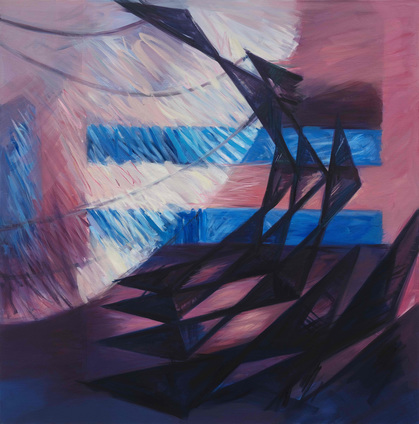-
From Current Issue
-
- Editor’s Letter Fire in the Heart
- Reviews I Gusti Ayu Kadek Murniasih
- Reviews 11th Seoul Mediacity Biennale: “One Escape at a Time”
- Dispatch Networked China
- One on One Monira Al Qadiri on Yukio Mishima
- Essays The rise of independent art spaces in pandemic-era Shanghai
- Features Tuan Andrew Nguyen
- Table of Contents
- Web Exclusives
- Archive
- Subscribe

R
E
V N
E
X
T
Installation view of XU QU’s “Fineness,” at Massimo De Carlo, Hong Kong, 2019. Courtesy Massimo De Carlo, Hong Kong / Milan / London.
Amid the ongoing Sino-American trade war, stagnant global economies, and widespread escalations of political tensions, Xu Qu’s solo exhibition “Fineness” was a timely presentation. “Fineness” is translated from cheng se, Xu’s Chinese title for the series that was displayed. In addition to referencing the vibrant colors of Xu’s painted canvases, the term describes the relative purity of precious metals in bullion, and alludes to the artist’s continued interests in examining global powers and realities through monetary systems.
This theme of dissecting economic structures ran throughout the show, mounted at Hong Kong’s Massimo De Carlo gallery. The selection of Xu’s new oil paintings featured distorted shapes, such as circles and stars, depicted with short, broad, painterly brushstrokes, and contrasting palettes. These motifs are drawn from various paper currencies, specified in the respective titles of the pieces, which include RMB 100, USD 1, Euro 5, Euro 100, and Euro 500 (all works 2019). Though not evident in the show, Xu had explored this theme previously, in the exhibition “Currency Wars” (2015) at Brussels’s Almine Rech Gallery, which comprised bold, geometric, over-sized renderings of watermarks, taken from the bills of different countries. Viewers were able to turn the paintings, each displayed on a movable stand, interacting with them in such a way that emphasizes the pliability of financial markets.
The Fineness series, by contrast, focuses on the iconographic designs of different bank notes. Hung on the gallery’s white walls, the rectangular canvases functioned somewhat like windows that offered reflections of the circumstances of each of the areas represented by the bills, with the arrangement of the works also serving to highlight the regions’ relationships with each other, propelling the show’s commentary on current global realities. Hung next to each other by the gallery’s door was RMB 100 and USD 1—a pairing that gestured toward the trade war. The Chinese note features a bundle of red peonies. Aside from being auspicious, red has come to be associated with communism in China, while the luscious flower is connected with wealth, befitting of a nation that has dramatically increased its global economic dominance over less than half a century with its development of a socialist market economy. Meanwhile, the United States dollar is a dark-green mass interwoven with layers of lighter strokes; the dark shades evoke a sense of melancholia, while also suggesting the versatility of the currency itself. This was underscored by Xu’s blurring of the bill’s design, suggesting the physical deterioration of the paper note through widespread usage. The contrast between the two pieces accentuates the difference between the two currencies, the former being a relatively new force in global markets, while the latter has a long-established position.
On a wall by itself, and directly facing the US note was HKD 10, hinting at the fact that the latter’s currency is pegged to the former, and signifying the strong American cultural influence on the city. Elsewhere in the exhibition, Euro 5, 100, and 500 formed a triangle across from each other, each with a constellation of stars originally meant to symbolize the unity of the entities that make up the European Union―incongruous with the current tribulations unfolding on the continent, such as recent French-Italian tensions, and the continuous uncertainties surrounding Brexit negotiations. While the euro was well represented, constituting the subject of half of the paintings, the British pound was notably absent despite its monetary significance and historical connection to Hong Kong, the exhibition’s host city. Although Xu created one such piece based on the British pound, its inclusion in the show was sacrificed for the aesthetics and layout of the exhibition space, according to the artist.
As a whole, Xu’s exhibition was an engaging exercise in capturing the current global state of affairs. The paintings’ lack of apparent narratives prompted viewers to arrive at their own interpretations of the artworks and of the convoluted web of relations that they represent, instilling dialogue.
Lauren Long is ArtAsiaPacific’s news and web editor.
Xu Qu’s “Fineness” was on view at Massimo De Carlo gallery, Hong Kong, from September 20 to October 26, 2019.
To read more of ArtAsiaPacific’s articles, visit our Digital Library.


















